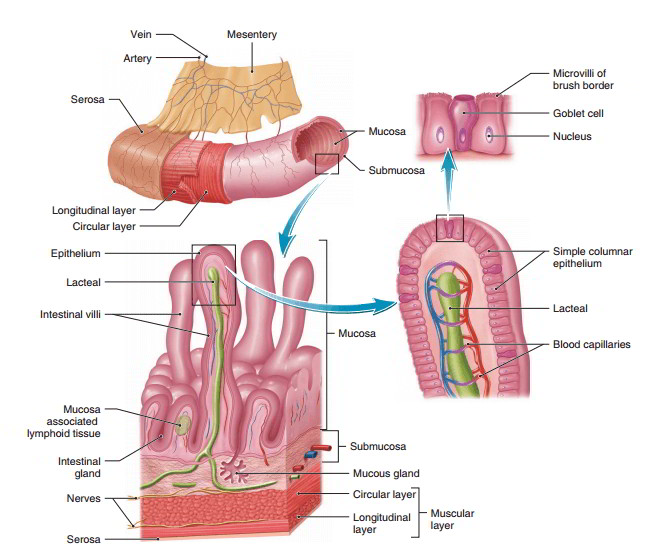The alimentary canal is a muscular tube about 5 m (20 ft) in length that extends from the esophagus to the anus. Various portions of the alimentary canal are specialized to perform different digestive functions. The hollow space within the alimentary canal through which food passes is called the lumen.
Structure of The Wall
The wall of the alimentary canal consists of four layers. From superficial to deep, the layers are called the serosa, muscular layer, submucosa, and mucosa. These layers may be modified in the various regions but remain as distinct layers.
The serosa is the most superficial layer. It consists of the visceral peritoneum and is continuous with the parietal peritoneum, which lines the internal surface of the abdominal wall. Cells of the peritoneum secrete peritoneal fluid, which keeps the membrane surfaces moist and reduces friction as parts of the alimentary canal rub against each other and the abdominal wall.
The muscular layer lies just deep to the serosa. It consists of two layers of smooth muscle that differ in the orientation of their muscle cells. Muscle cells of the more superficial muscular layer are arranged longitudinally. Their contractions shorten the tube. Muscle cells of the deeper muscular layer are arranged circularly around the tube. Their contractions constrict the tube.
The submucosa lies between the muscular layer and the mucosa. It contains nerves, mucous glands, lymphatic vessels, and blood vessels embedded in areolar connective tissue.
The deepest layer is the mucosa. It consists of an epithelium that is in direct contact with the lumen and is supported by areolar connective tissue containing a few smooth muscle cells. The epithelium is often folded to increase the surface area that is in contact with food. The mucosa has different functions in different parts of the alimentary canal. In some regions, it secretes only mucus, which protects underlying cells. In others, it secretes mucus and digestive secretions containing enzymes and absorbs nutrients.
Movements
Contraction of the smooth muscle layers produces two different types of movement in the alimentary canal: mixing movements and propelling movements. Mixing movements are called segmentation and involve ringlike contractions followed by relaxation at multiple places along the alimentary canal. The alternating segmental contractions help to mix the food with the digestive secretions. These are especially frequent in the small intestine.
The movement that propels food through the alimentary canal is called peristalsis (per-i-stal’-sis). In peristalsis, coordinated contraction and relaxation of the circular and longitudinal muscular layers produce a wave of contraction along the alimentary canal that pushes the food in front of it. The movement resembles pushing toothpaste along a toothpaste tube towards its opening. In this way, peristaltic contractions move food from one portion of the alimentary canal to another.




